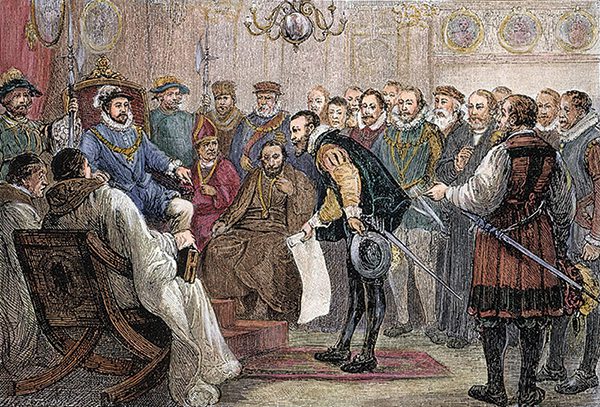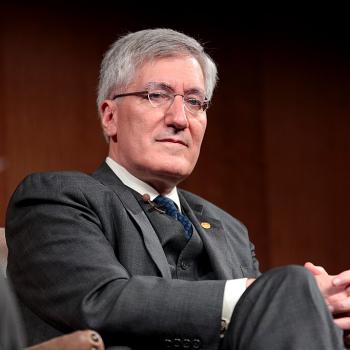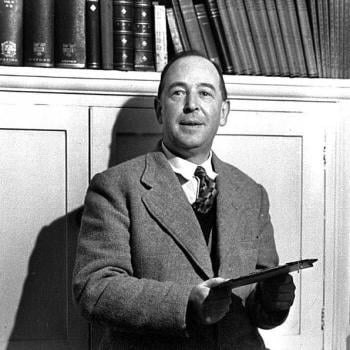Last Saturday was the 492nd anniversary of the presentation of the Augsburg Confession on June 25, 1530. Nine years earlier, Martin Luther–all alone–confessed his faith before the Emperor, Charles V, at the Diet of Worms. Now, at the Diet of Augsburg–the term “diet” referring to the Emperor’s legislative body of nobles–seven princes and the representatives of two cities confessed their faith by presenting the Augsburg Confession, which summarized the teachings of the Reformation, to the Emperor.
Before long, more and more principalities, cities, and even countries (Sweden, Norway, Finland, Denmark, and Iceland) would sign on, along with an untold number of theologians and congregations.
The Augsburg Confession became the definitive statement of faith for Lutheran Christianity. It was written not by Martin Luther, but by the classical scholar Philipp Melanchthon, a layman. But it succinctly and richly sets forth what it means to be Lutheran. But because it was written to reassure the Emperor that the evangelical movement was not some quirky cult or new religion, but rather that it is historic, orthodox Christianity, the Augsburg Confession can speak to all Christians.
To respond to the papal critics, Melanchthon also wrote a defense of the various articles in the document known as the Apology of the Augsburg Confession, which also became a confessional document.
You can read the Augsburg Confession, which consists of 28 articles, here. In belated celebration of the anniversary, I will post a few highlights:
Article I. Of God.
1 Our Churches, with common consent, do teach that the decree of the Council of Nicaea concerning the Unity of the Divine Essence and concerning the Three Persons, is true and to be believed without any doubting; 2 that is to say, there is one Divine Essence which is called and which is God: eternal, without body, without parts, of infinite power, wisdom, and goodness, the Maker and Preserver of all things, visible and invisible; and 3 yet there are three Persons, of the same essence and power, who also are coeternal, the Father, the Son, and the Holy Ghost. And the term “person” 4 they use as the Fathers have used it, to signify, not a part or quality in another, but that which subsists of itself.
Article III. Of the Son of God.
1 Also they teach that the Word, that is, the Son of God, did assume the human nature in 2 the womb of the blessed Virgin Mary, so that there are two natures, the divine and the human, inseparably enjoined in one Person, one Christ, true God and true man, who was born of the Virgin Mary, truly suffered, was crucified, dead, and 3 buried, that He might reconcile the Father unto us, and be a sacrifice, not only for original guilt, but also for all actual sins of men.
Article IV. Of Justification.
1 Also they teach that men cannot be justified before God by their own strength, merits, or works, but are freely justified for 2 Christ’s sake, through faith, when they believe that they are received into favor, and that their sins are forgiven for Christ’s sake, who, by His death, has made satisfaction for our sins. 3 This faith God imputes for righteousness in His sight. Rom. 3 and 4.
Article X. Of the Lord’s Supper.
1 Of the Supper of the Lord they teach that the Body and Blood of Christ are truly present, and are distributed 2 to those who eat the Supper of the Lord; and they reject those that teach otherwise.
Article XII. Of Repentance.
1 Of Repentance they teach that for those who have fallen after Baptism there is remission of sins whenever they are converted 2 and that the Church ought to impart absolution to those thus returning to repentance. Now, repentance consists properly of these 3 two parts: One is contrition, that is, 4 terrors smiting the conscience through the knowledge of sin; the other is faith, which is born of 5 the Gospel, or of absolution, and believes that for Christ’s sake, sins are forgiven, comforts 6 the conscience, and delivers it from terrors. Then good works are bound to follow, which are the fruits of repentance.
Article XIII. Of the Use of the Sacraments.
1 Of the Use of the Sacraments they teach that the Sacraments were ordained, not only to be marks of profession among men, but rather to be signs and testimonies of the will of God 2 toward us, instituted to awaken and confirm faith in those who use them. Wherefore we must so use the Sacraments that faith be added to believe the promises which are offered and set forth through the Sacraments.3 They therefore condemn those who teach that the Sacraments justify by the outward act, and who do not teach that, in the use of the Sacraments, faith which believes that sins are forgiven, is required.
Article XVI. Of Civil Affairs.
1 Of Civil Affairs they teach that lawful civil ordinances are good works of God, and that 2 it is right for Christians to bear civil office, to sit as judges, to judge matters by the Imperial and other existing laws, to award just punishments, to engage in just wars, to serve as soldiers, to make legal contracts, to hold property, to make oath when required by the magistrates, to marry a wife, to be given in marriage.
Article XVIII. Of Free Will.
1 Of Free Will they teach that man’s will has some liberty to choose civil righteousness, and to work 2 things subject to reason. But it has no power, without the Holy Ghost, to work the righteousness of God, that is, spiritual righteousness; since the natural man 3 receiveth not the things of the Spirit of God, 1 Cor. 2:14; but this righteousness is wrought in the heart when the Holy Ghost is received 4 through the Word.
Article XXIV. Of the Mass.
1 Falsely are our churches accused of abolishing the Mass; for the Mass is retained among 2 us, and celebrated with the highest reverence. Nearly all the usual ceremonies are also preserved, save that the parts sung in Latin are interspersed here and there with German hymns, which have been added 3 to teach the people.
The articles start short, but then get a little long, and they are divided between “The Chief Articles of Faith,” I-XXI, and “Articles in which are reviewed the abuses which have been corrected,” XXII-XXVIII, such as allowing priests to marry, the critique of monastic vows, and insisting that ecclesiastical power has to do with preaching the gospel and administering the sacraments and not civil authority,
Vocation is covered in XIV, “Of Ecclesiastical Order”; XX, “Of Good Works”; XXVI, “Of the Distinction of Meats”; XXVII, “Of Monastic Vows”; and XXVIII, “Of Ecclesiastical Power.”
We usually treat October 31, 1517, when Luther posted his 95 Theses, as the beginning of the Reformation. But, as our pastor Ned Moerbe said, that event may have got things rolling, but much of that document still reflected medieval Roman Catholic theology. With the Augsburg Confession, though, which took form out of extensive Bible study and theological reflection by many people, the content of the Reformation took shape. Thus, June 25 is the true Reformation Day.
Illustration: Presentation of the Augsburg Confession, 1530, 19th century engraving. Via Lutheran Church of Canada.












